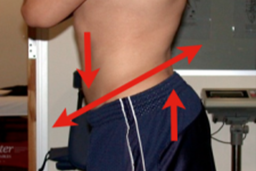
Anterior Pelvic Tilt is a condition in which the front of the pelvis sits lower than the back of the pelvis, creating a forward rotation and causing the chest/ribcage to be situated upward with a pronounced curve in the lower spine. It is seen as an epidemic in today’s world, with the leading theories as to the cause being lifestyle changes, a large amount of sitting and slouching in the workforce, poor posture in children watching television or using cell phones, as well as tight hip flexors and weak gluteal muscles.
What Causes Pelvic Tilt?
Pelvic tilt develops with the overuse of specific muscles that act on the pelvis while in the positions mentioned above. These overworked muscles pull the anterior aspect (front) of the pelvis forward while the core remains inactive. This leads to neuromuscular inefficiency and aids in the development of a lazy, inactive posture, which the brain begins to default to because it is an easier position to maintain.
Why is it bad?
An anterior pelvic tilt can create unwanted lower back extension and upper back kyphosis (flexion), as well as hip mobility issues. These poor movement patterns can lead to poor posture and may contribute to worsening pain later in life due to these compensatory patterns. This is better known as lower cross syndrome, which constitutes weak glutes, tight erector spinae, weak core, and tight iliopsoas (hip flexors).

Janda’s Lower Cross Syndrome
How To Treat It?
When treating and training an anterior tilt, we utilize a 5 step method:
-
- Inhibit
- Align
- Mobilize
- Activate
- Stabilize
Let’s take a brief look at each:
-
- Inhibit – use positional breathing drills to to “turn off” tension in the lat and lower lumbar area while helping to “turn on” the abs. One great exercise we use here at RPP is “Deep Squat Breathing”. This exercise focuses on parasympathetic stimulation by exhaling fully to help relax the body before working out while helping to reverse thew anterior-tilted posture
TRX Deep Squat Breathing
-
- Align – asymmetries can be seen in pelvic tilt, such as one hip presenting higher than the other. The 90/90 hip shift can be utilized to correct differences between the sides of the innominate bone.
90/90 Hip Shift
-
- Mobilize – Most people will start here- and by doing so can lead to poor movement patterns- If we skipped steps 1 & 2, and started working on mobility while being out of alignment, we would be essentially torquing the body in the wrong areas. The big 4 mobility -wise would be the Q.L, Lat, Psoas and TFL.
Band Resisted 90/90 Hip Flexor
-
- Activate / Strengthen – Activating and strengthening glutes and core with planks or dead bugs is crucial for establishing proper movement patterns. Examples of activation exercises include deadlift, pull-throughs, and slide board hamstring curls.
-
- Stabilize – Work to develop core stability and strength through an active range of motion. Examples of these exercises include (but aren’t limited to) bird dogs, dead bugs, stability ball rollouts, and chops.
Cable Chop
Following these steps to treat and correct an anterior pelvic tilt is just one piece of the puzzle, as it takes effort and consistency to maintain the changes created by the corrective exercises. Without consistency with treatment, and changing postural lifestyle choices that developed the pelvic tilt in the first place, the initial effort to fix the issue will be fruitless in its outcome.
By Morgan LaBuda – Strength and Conditioning Intern from Penn State University attending our Fall internship.
